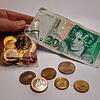The Stockach Room: 20 years of the Euro: When people line up at Stockach banks on New Year’s Day

In the sharp midnight of 20 years ago, it was time: ATMs began issuing the first euro bonds on January 1, 2002. Starter sets with coins were available two weeks ago and were in great demand at Stockach Bank branches. “The machines were programmed by the computer center so that they issued D-Marks until midnight on New Year’s Eve and then after midnight,” explains Gerhard Seeberger, bank manager at Volksbank Berlingen-Stockach. However, the Stockachers would initially have had small amounts and bills so small that the trade would not need much alteration.
Volksbank opened both branches on New Year’s Eve, says Seiberger: “Customers stood in line for hours.” It was actually open from 10am to 2pm but the staff at the cash registers served people until everyone was gone. Seeberger supported his colleagues as a New Year’s point of contact. However, he had to deal with currency conversion, mainly through questions from corporate clients about account transfer or the like.
Sabine Loehr, individual customer advisor at Sparkasse in Stockach, reported on New Year’s Day 2002 that branches were open. “At the beginning of the year there was a higher frequency at our branches and always still is, but the waiting lists at the beginning of 2002 were significantly longer,” she says.

Goodbye German Mark! The Euro Starter kit can be seen on the left. | Photo: Lffler, Ramona
Money was in the bank earlier
Preparations for the euro change began too soon, according to Seiberger. There were business groups and media events throughout 2001. Then the new money was delivered to bank branches three months before the start of the 2001/02 year, Seiberger said. That’s why you had to keep extra space in the safe and increase your deposit amounts accordingly. “We were allowed to issue coins to retailers two months before New Year’s Eve,” he says. However, all companies had to commit in writing not to use the new money before January 1, 2002.
Regarding the challenges, Sabine Loehr recalls that two cash registers had to be kept in the branches – one for the German mark and one for the euro. “At the same time, storing the double cash stock was certainly a particular challenge.”
The first coins came in the starter set
From December 15, 2001, private customers will have the opportunity to acquire European starter kits. This bag holds €10.23, which was available for 20 D-Marks. Interest in these groups has been very high, according to Sieberger. Sabine Loehr says this too. She adds that there were 20 coins in this set, which would have been worth €10.23. About 53 million copies of these starter sets were released in Germany at the time.
Sabine Loehr explains that preparing for the currency conversion required a lot of work. The introduction of the euro was very exciting for everyone involved. “The population’s interest was very high, so people were asked about the new banknotes and coins even before the official change of cash,” she says. The euro was introduced as book money on January 1, 1999: “From that day onwards, accounts could be kept in euros, and then securities were also priced in the common European currency.” Set the new currency.
The subsequent delivery of euro banknotes and coins was said to have taken place under the strictest secrecy. You well remember that as of January 1st there was a lot of interest in new coins and some coins. “Forex was particularly interesting here and it was scarce at first,” she says.

D-Mark Coins and Note. | Photo: Lffler, Ramona
And what happened to D-Mark?
Customers were able to exchange D-Mark for euros. Even today someone still comes up with the old coin from time to time. But that only happens four to six times a year at Volksbank, Seiberger says. Sometimes people still find something in homes, especially after inheritance. In some cases, customers will still have the option to exchange German marks for free, but the coins that are found will often end up in donation boxes. At the Landeszentralbank branch in Villingen, everything can still be exchanged for euros, regardless of whether it is bills or coins.
Sabine Loehr can also confirm: “Even today customers come to us from time to time who want to exchange German brands for euros.” After converting the currency. “According to Bundesbank estimates, there are still about twelve billion D-Marks in circulation,” explains Sabine Loehr. “We now only offer currency exchange to our customers. We exchange live banknotes directly on site, and send coins to the Bundesbank.”

One D-Mark | Photo: Lffler, Ramona
Looking back, Gerhard Seeberger, who also spoke to his current and former colleagues about currency conversion 20 years ago, says that inflation with the euro is at the same level as it is with the German mark. So there were no fears of an increase. The change went better than expected.
It was just a lot of extra work for the cashier, it took a lot of coordination, there were two cash balances at the same time and a lot of old currency had to be sent away. Many companies later returned coins they would not have used as change.
Four memories for the first time with the new currency euro
An editor and three freelance journalists from the local Stokachs editorial team tell tales about the introduction of the euro and memories from the early days of the new currency.
- Ramona Feller: In early 2001/02 I had two friends who were incredibly excited and wanted to see the new Euro bills as quickly as possible and put them in their wallets. After the fireworks, an air of optimism soon reigned over the next ATM. Although without me. The next morning was enough for me. At the time, I already had a euro coin operated kit. Today I still carry it in its original packaging as a keepsake. In it there are 10.23 euros, which is equivalent to 20 D-Marks. I also have 20 notes and some DM coins. The coins were planned, but the banknote was a coincidence because my grandmother, who has since passed away, found it years later and gave it to me. From time to time I held foreign Euros that I found beautiful or unusual – even today.
- Doris Eichkorn: At that time we bought euro scrapbooks for our children (born in 1998 and 2000), and since the first release I have been busy looking for coins in my wallet. We’ve always looked to see if a coin lost since our last purchase has found its way there, just waiting to be discovered and collected. At some point, of course, the hunters’ euphoria subsided, so there are still little gaps in the album today. What we’ve never encountered while hunting are the Vatican Coins, whose one-euro coins bear the image of the Pope in question. There is also another small group that has special editions.
- Konstanz Wyneken: Buses in Dublin are called banana buses. This is because they are large and yellow and none or many come at once. When I arrived in the capital of the Republic of Ireland on January 1, 2002, I boarded this banana bus with my mother. I already had the exact amount of euro cent coins in my pocket and put them on the bus driver’s counter. He marveled at each of these coins, then took out his cups and folded the coins further. Then he said he wouldn’t accept this play money, but he would take us with him and drive his car.
- Claudia Ladwig: When the euro was introduced, my parents gave each of our three sons a scrapbook with compartments for all the new coins. Since then, we have collected – from our grandparents as well as from us. Each coin was received upon shopping delivery and carefully considered. It was astonishing how quickly foreign currencies were mixed with German currencies. Finding out where the new money came from was always an adventure, and the boys were proud of being able to sort out a rare copy. I remember I always did the conversion at the beginning: 1 euro is roughly equivalent to 2 German marks, if you look at it as a rule. I regretted a little that we would pay the same money on vacations abroad as we did here, because I always found foreign money to be something special, but, of course, the euro made shopping easier.

Communicator. Reader. Hipster-friendly introvert. General zombie specialist. Tv trailblazer






